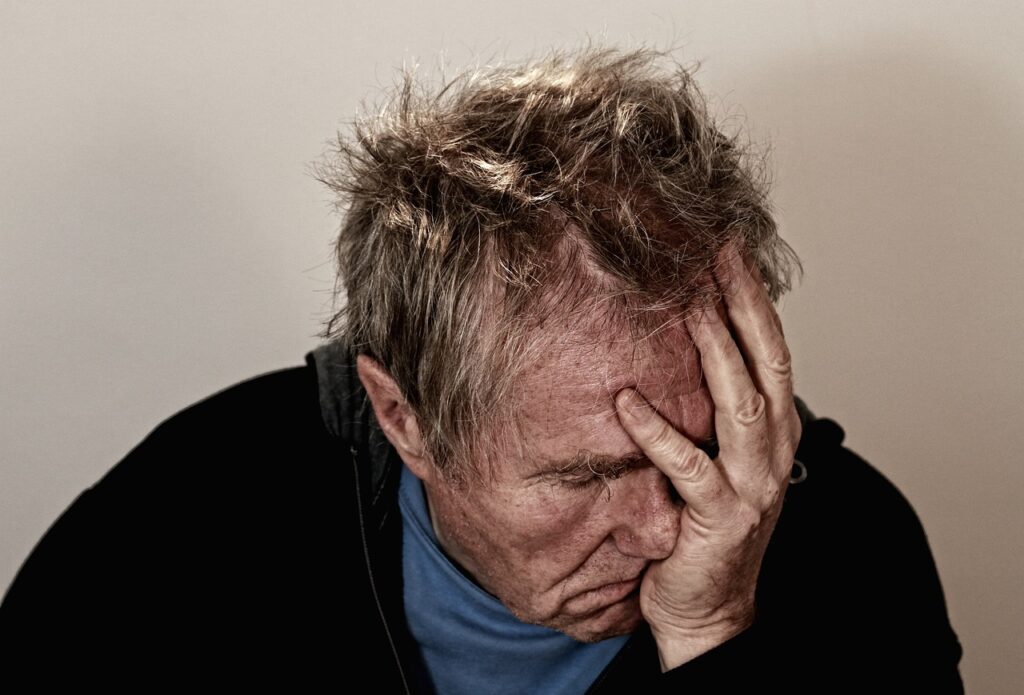Depression in older adults is more complex than many realize. It’s often described as a single condition, but it’s actually a mix of different types, especially in aging. The term “depression” is widely used, but this can cause confusion because it ranges from a mild feeling of sadness to a more severe form of depressive disorder (Hegeman et al., 2012). This confusion impacts how we study depression, especially in later life. Let’s take a closer look at the different forms of depression and how we define them.
What Does “Depression” Really Mean?
The term “depression” covers many different conditions, from feeling sad to more serious mental health disorders. Here’s a breakdown of the different ways depression can be defined:
- Depressed Mood: A single symptom of feeling sad, which can lead to more serious depression.
- Depressive Symptoms: These are signs of depression that might be measured by self-reports or professional assessments.
- Clinically Relevant Depressive Symptoms (CRDS): Symptoms that meet a threshold for major depressive disorder.
- Adjustment Disorder with Depressed Mood: Depression caused by a specific stressor, like losing a job or a loved one.
- Minor Depression: When someone has some but not all symptoms of major depressive disorder, affecting daily life.
- Depressive Disorder with Insufficient Symptoms: A diagnosis for people who don’t meet all the criteria for major depression but still experience distress.
- Subthreshold Depression: A type of depression that doesn’t quite meet the official criteria but still causes distress.
- Major Depressive Disorder (MDD): A full, severe form of depression diagnosed based on clinical criteria.
- Dysthymia/Persistent Depressive Disorder: Chronic low mood lasting for at least two years.
While many studies use the term “depression” to describe all of these types, they’re often seen as a spectrum, ranging from mild symptoms to severe depression. However, not everyone agrees with this idea, and it’s important to look at the different types separately (Meeks et al., 2011).
Is Depression a Spectrum or Something Else?
It’s common to think of depression as a spectrum, where people with milder symptoms are on one end and those with severe depression are on the other. Research has shown that milder depression in older adults might have similar health risks to severe depression (Ayuso-Mateos et al., 2010). But this view doesn’t always explain how depression shows up in older adults or how its severity impacts health and quality of life (Lorenz et al., 2020))
Depression May Be Different in Later Life
An alternative theory, called the “discontinuity hypothesis,” suggests that depression in older adults isn’t just a continuation of earlier depression. Instead, it might be something entirely different. This view argues that the causes and effects of depression change as we age.

How Depression Manifests in Older Adults
Depression in older adults is often overlooked because it is masked by other symptoms like memory problems, anxiety, and distress. These issues are often mistaken for normal aging, which can delay proper diagnosis and treatment (Blazer, 2003).
- Impact of Depression: Depression worsens physical disabilities, interferes with treatment, and accelerates the decline in physical functioning in older adults (Saxena et al., 2013-2020). It also leads to significant economic costs due to increased healthcare needs (Luppa et al., 2007). Given these factors, improving mental health care for the elderly is essential to prevent increased suicide rates as the population ages.
What Research Tells Us About Depression in Older Adults
Research has traditionally shown that depression is more common in older adults, but recent studies tell a different story. One study of over 146,000 people found that depressive disorders peaked in people between 30 and 50, and then declined after that age. However, depressive symptoms in older adults remained stable or even increased after 65 (Van Loo, et al., 2021). This suggests that depression in older age could be different from the depression seen in younger people.
What Is Late-Life Depression?

Late-life depression is a psychiatric disorder that significantly reduces the quality of life in older adults (Noël et al., 2004). According to the Diagnostic and Statistical Manual for Mental Disorders (DSM-5), diagnosing major depressive disorder requires at least five symptoms to be present nearly every day for two weeks. For minor depression, a minimum of two symptoms, including a depressed mood, must persist for at least two weeks (American Psychiatric Association, 2013).
Common Symptoms of Late-Life Depression
- Persistent sadness or hopelessness
- Loss of interest in previously enjoyed activities
- Changes in appetite or weight
- Sleep disturbances (insomnia or excessive sleeping)
- Fatigue or low energy
- Difficulty concentrating or making decisions
- Feelings of worthlessness or excessive guilt
- Physical symptoms with no clear medical cause
- Thoughts of death or suicide
The severity of these symptoms varies, and depression can be categorized as mild, moderate, or severe based on the level of functional impairment they cause (American Psychiatric Association, 2013).
Depression in Older Adults: A Global Issue
Depression is a leading cause of disability worldwide and is one of the most common psychiatric disorders in older adults (James et al., 2017). It significantly contributes to global health problems and is linked to higher disability and mortality rates in elderly patients (Blazer et al., 2001).
- Undiagnosed Depression: Around 50% of depression cases in elderly people go undiagnosed. The World Health Organization estimates that between 10% and 20% of older adults globally suffer from depression (Mitchell et al., 2005). Among all people with mental illness, 40% have depression (Patel et al., 2014), and those affected by depression are 40% more likely to die prematurely than those without it.
Who Is at Risk for Late-Life Depression?
Several risk factors contribute to the onset of depression in older adults. These include:
Biological and Medical Factors
- Chronic Illness: Conditions such as diabetes, heart disease, and arthritis increase the risk of depression (Vink et al., 2008).
- Cognitive Impairment: Dementia or other cognitive disorders can lead to depressive symptoms (Vink et al., 2008).
- Functional Impairment: Mobility limitations or disabilities contribute to feelings of helplessness (Vink et al., 2008).
Psychosocial Factors
- Lack of Close Social Contacts: Isolation and loneliness are strong predictors of depression (Vink et al., 2008).
- Personality Traits: Certain personality characteristics, such as high neuroticism, can increase susceptibility (Djernes, 2006).
- Stressful Life Events: The loss of a spouse, retirement, or financial difficulties can trigger depressive episodes (Djernes, 2006).
- History of Depression: Individuals with a history of depression are more likely to experience it later in life (Djernes, 2006).
Other Risk Factors for Depression in the Elderly
Several factors can increase the risk of depression in older adults, including:
- Gender: Women are more likely to experience depression (Cole and Dendukuri, 2003)
- Age: Depression risk increases with age (Munsawaengsub et al., 2012)
- Social Factors: Being single or divorced, loneliness, and social isolation can contribute to depression (Sengupta et al., 2015).
- Economic Factors: Low income, unemployment, and lack of health insurance are significant risk factors (Cole and Dendukuri, 2003).
- Health Issues: Chronic illness, poor health, cognitive impairment, and a history of depression can increase the risk (Djernes et al., 2006).
Apart from these, lower educational attainment, bereavement, traumatic childhood experiences, and smoking habits may also lead to depression later in life (Weyerer et al., 2013)
How Is Late-Life Depression Treated?
The treatment of depression in older adults follows the same approach as in younger individuals. The primary options include psychotherapy, medication, electroconvulsive therapy, and lifestyle interventions.
1. Psychotherapy: A First-Line Treatment
Psychotherapy is highly recommended as an initial treatment for mild to moderate depression 15. Various psychotherapeutic approaches have been found to be effective, including:
- Cognitive Behavioral Therapy (CBT): The most well-researched therapy for depression, CBT helps patients identify and change negative thought patterns. Meta-analyses show significant improvements, with effect sizes ranging from 0.70 to 1.34 (Wilson et al., 2008; (Gould et al., 2012)).
- Problem-Solving Therapy: A practical approach that teaches coping skills to manage everyday challenges.
- Interpersonal Therapy: Focuses on improving relationships and social support networks.
Psychotherapy is as effective as antidepressant medications and has fewer side effects, making it a preferred option for many older adults (Cuijpers et al., 2014; (Kirkham et al., 2016). However, its effectiveness in individuals over 75 years or those with frailty remains under-researched.
2. Antidepressant Medications: A Common but Challenging Option
Medications are commonly prescribed to manage depression in older adults. However, diagnosing and treating depression in older patients can be complicated due to physical comorbidities and cognitive dysfunction. Additionally, antidepressants may have side effects that are poorly tolerated in frail individuals.
3. Electroconvulsive Therapy (ECT): A Last-Resort but Highly Effective Treatment
For older adults with severe or psychotic depression, or those who cannot take medication due to medical conditions, electroconvulsive therapy (ECT) is the most effective treatment. Its success rate ranges from 60% to 80% (Unützer & Park, 2012; Taylor, 2014; Spaans et al., 2015). ECT is also recommended for patients who refuse to take medication due to severe depression-related malnutrition or worsening health conditions (Alexopoulos et al., 2001;Unützer & Park, 2012; Taylor, 2014)
4. Exercise: A Natural Mood Booster
Although high-quality clinical trials on exercise and depression in older adults are limited, existing studies suggest that exercise offers moderate benefits. It is particularly effective when compared to usual care or placebo interventions (Bridle et al., 2012; Mura & Carta, 2013). Exercise programs can be beneficial for older adults, even those over 75, provided they are willing to engage in physical activity.
Causes of Late-Life Depression

The causes of depression in the elderly are complex, involving a mix of psychological, social, and biological factors. While the exact causes remain unclear, experts believe that these factors work together to contribute to depression in older adults.
- Psychosocial Theories: Depression can stem from a lack of social support, poor communication skills, and coping mechanisms (Gonzalez et al., 1990).
- Biological Theories: Earlier theories suggested that depression was caused by a lack of certain brain chemicals. However, recent research points to the role of Brain-derived neurotrophic factor (BDNF) in depression development (Dwivedi et al., 2009).
Depression in older adults is a widespread yet often overlooked mental health issue. Nearly 14% of individuals over the age of 55 experience depression, with around 2% suffering from major depressive disorder (Beekman et al., 1999). While major depression is less prevalent in older adults compared to younger individuals, its occurrence rises sharply among those over 85 years old, as well as in hospitals and nursing homes (Luppa et al., 2012).
Understanding and addressing late-life depression is essential for improving the overall well-being of aging individuals. This article explores the causes, symptoms, and most effective treatment options available for older adults battling depression.
Understanding the Shifting Causes of Depression with Age
As people get older, the types of depression they experience change. Research shows that milder forms of depression are more common in older adults, while more severe forms tend to decrease. One reason could be changes in the causes of depression as we age. A study looking at genetic data found that everyone has some genetic risk for depression, suggesting a continuous underlying risk. However, the genetic risk for depression seems to decrease as we get older, pointing to the idea that other factors play a bigger role in later life (Wray et al., 2018)
Older adults may also be more resilient and better at managing their emotions, which could help explain why they experience fewer severe depressive disorders. Studies show that older adults are often better at controlling negative emotions, which could explain why severe depression is less common in this group (Luppa et al., 2012). According to the “on-time, off-time” hypothesis, while older adults experience stressors like loneliness and health problems more frequently, these stressors might have a stronger emotional impact on younger people. Older individuals may feel depressed due to these stressors, but it doesn’t always lead to full depression.
Several factors related to aging, such as changes in blood vessels, cognitive decline, frailty, dopamine issues, and low-grade inflammation, are becoming recognized as possible risk factors for depression. While many older adults experience these changes, not everyone will develop clinical depression. These factors can cause a depressed mood but may not lead to a depressive disorder, depending on the person’s individual risk for depression (Luppino et al., 2010).
Depression: A Geriatric Syndrome
Depression in older adults is often considered a “geriatric syndrome.” Unlike medical conditions that are linked to one specific cause, geriatric syndromes involve a combination of factors that affect older adults and can lead to serious health problems. While depression in later life is complex and caused by many factors, it’s important to understand that depression in older adults might be different from depression as a psychiatric disorder. This distinction is crucial in elderly care, as managing depression may require different strategies depending on whether it’s seen as a normal part of aging or as a clinical condition that needs treatment (Wang et al., 2020).
How Physical Illnesses Can Look Like Depression

In older adults, physical aging or illness symptoms like fatigue or trouble concentrating can sometimes be mistaken for depression. A study called AgeMooDe, which looked at 1,197 participants aged 75+, found that when people had physical health issues, they often showed depression-like symptoms, but these didn’t always mean they had a clinical depressive disorder. This suggests that depression might be overdiagnosed when using certain tools in older adults who are also dealing with chronic health conditions.
Physical changes due to aging can lead to symptoms like low mood and a lack of interest in activities, which may overlap with symptoms of depression. Studies on late-life depression show that many of the cases aren’t diagnosed according to psychiatric criteria, making it harder to tell if someone is dealing with real depression or just the effects of aging (Soysal et al., 2017). This is important because conditions like heart disease may show a link between depression and physical health, and low depression scores may actually reflect other underlying health problems (Thombs et al., 2010). Moreover, the symptoms of frailty and depression often overlap, but frailty doesn’t always indicate depression (Lohamn et al., 2016). Depression scales for older adults, such as the GDS-15, sometimes don’t fully capture the physical symptoms of depression, which are especially common in older age (Hegeman et al., 2012).
Is Depression a Warning Sign for Neurodegenerative Disorders?
The link between depression and neurodegenerative diseases like dementia is still unclear. Some studies suggest that depression might cause dementia, while others propose that depression is an early sign of dementia, showing up before the disease fully develops. There is evidence supporting both ideas. For example, research has shown that more severe depression may increase the risk of dementia later in life, especially if depression starts in middle age (Stafford, 2022). A large study in Denmark found that midlife depression doubled the risk of dementia (Larsen et al., 2022).
However, other research suggests that depression, especially when it starts later in life, could be an early warning sign of dementia. Studies have shown that symptoms of depression can appear years before dementia, and that people with increasing depression over time are more likely to develop dementia. This means that depression could either be a cause of dementia or a symptom of it, depending on the individual case.
The Growing Impact of Aging Populations on Mental Health
As people age, they bring valuable wisdom and experience to society. However, the increasing number of elderly people worldwide is creating social and economic challenges . This rise in the elderly population is largely due to lower mortality and fertility rates, as well as improvements in quality of life, which have increased life expectancy (Bujang et al., 2012).
- Current Statistics: In 2019, there were 1 billion people aged 60 and older globally. By 2030, this number will rise to 1.4 billion and reach 2.1 billion by 2050. By that time, 80% of older people will be living in low- and middle-income countries (World Health Organization, 2016).
As this elderly population grows, so do the mental health challenges, especially depression. Older adults face physical and psychological changes that contribute to mental health struggles, and the incidence of mental health issues is expected to rise, particularly in the elderly.
Problems with Depression Screening in Older Adults
Another reason the discontinuity theory makes sense is that depression screening tools don’t always work well for older adults. For example, the Geriatric Depression Scale (GDS-15) has only moderate accuracy in diagnosing depression in older adults (Dorrow et al., 2018). This is especially true because physical illnesses, cognitive decline, and other age-related changes can cause symptoms similar to depression, leading to more false positives (Beekman et al., 1997).
Does Severity of Depression Impact Health?
In the dimensional model of depression, the severity of symptoms is thought to directly affect health outcomes, including mortality. However, some studies have shown no clear link between the severity of depression and the risk of death (Beekman et al., 1997). In fact, some research even suggests that milder forms of depression might be linked to lower mortality risk, indicating that mild depression in older adults might reflect other health problems rather than being a direct cause of poor health (Berg et al., 2021)
Rethinking Depression in Later Life
As research continues, it’s becoming clear that depression in older adults may not fit into the simple model of a spectrum from mild to severe. Instead, it’s more likely that depression in later life could be a separate phenomenon with its own causes and effects. Understanding this will help improve how we diagnose and treat depression in older adults.
Depression and Physical Illnesses
In older adults, symptoms like fatigue and trouble concentrating—often linked to aging or chronic illness—are sometimes mistaken for depression. The AgeMooDe study, which involved nearly 1,200 participants aged 75 and older, found that people with symptoms matching depression scales (like the GDS-15 or HADS) had higher disability, but it didn’t always mean they had clinical depression (Dorrow et al., 2018). In fact, illnesses like heart disease can cause symptoms that look like depression (Van Melle et al., 2005). This confusion between physical illness and depression is common, especially in older adults.
Depression and Neurodegenerative Diseases
Another question is whether depression in older adults could be linked to neurodegenerative diseases, like dementia. Some studies suggest that depression might increase the risk of developing dementia, especially in midlife. Others argue that depression could be an early sign of dementia. For example, a study of almost 600,000 men found that depression in midlife doubled the risk of later dementia (Larsen et al., 2022). However, late-life depression is often more strongly associated with dementia, showing that both theories might be true in different cases (Stafford et al., 2022).
These different theories suggest that treating depression in older adults might require different approaches, depending on whether depression is seen as a cause or a warning sign of neurodegenerative diseases.
Challenges in Addressing Depression in Older Adults
Despite the high prevalence of depression among older adults, the issue is often under-addressed in healthcare systems. There is limited research and evidence on how to effectively manage depression in elderly populations, leading to inconsistent care and treatment in many communities (Bitew, 2014).
- Inconsistent Prevalence Rates: Different studies show varying rates of depression in older adults, making it difficult to understand the full scope of the issue. This systematic review and meta-analysis aims to provide a clearer picture of depression prevalence and its impact on the elderly population. The findings are intended to help clinicians, researchers, and policymakers improve care for older adults.
Final Thoughts: Improving Mental Health in Older Adults
Late-life depression is a serious yet treatable condition. While it may not always be preventable, early intervention and a combination of therapy, medication, and lifestyle changes can significantly improve the quality of life for older individuals. Encouraging social engagement, promoting physical activity, and ensuring access to mental health care are crucial steps in addressing this widespread issue.
If you or a loved one are struggling with symptoms of depression, seeking professional help is the first step toward recovery.
References
Alexopoulos, G. S., Katz, I. R., Reynolds, C. F., III, Carpenter, D., Docherty, J. P., & Ross, R. W. (2001). Pharmacotherapy of depression in older patients: A summary of the expert consensus guidelines. Journal of Psychiatric Practice, 7(6), 361-376.
American Psychiatric Association. (2010). Practice guideline for the treatment of patients with major depressive disorder (3rd ed.). Arlington, VA: American Psychiatric Association.
Ayuso-Mateos, J. L., Nuevo, R., Verdes, E., Naidoo, N., & Chatterji, S. (2010). From depressive symptoms to depressive disorders: The relevance of thresholds. British Journal of Psychiatry, 196(5), 365–371. https://doi.org/10.1192/bjp.bp.109.073336
Beekman, A. T., Deeg, D. J. H., Limbeek, J., Braam, A. W., Vries, M. Z., & Tilburg, W. (1997). Criterion validity of the Center for Epidemiologic Studies Depression Scale (CES-D): Results from a community-based sample of older subjects in the Netherlands. Psychological Medicine, 27(1), 231–235. https://doi.org/10.1017/S0033291796004189
Berg, K. S., Wiersema, C., Hegeman, J. M., et al. (2021). Clinical characteristics of late-life depression predicting mortality. Aging & Mental Health, 25(3), 476–483. https://doi.org/10.1080/13607863.2019.1649048
Bitew T. Prevalence and risk factors of depression in Ethiopia: a review. Ethiop J Health Sci. 2014;24(2):161–169. doi: 10.4314/ejhs.v24i2.9.
Blazer DG, Hybels CF, Pieper CF. The association of depression and mortality in elderly persons: a case for multiple, independent pathways. J Gerontol A Biol Sci Med Sci. 2001;56(8):M505–M509. doi: 10.1093/gerona/56.8.m505.
Blazer DG. Depression in late life: review and commentary. J Gerontol A Biol Sci Med Sci. 2003;58(3):M249–M265. doi: 10.1093/gerona/58.3.m249.
Blazer DG. Depression in late life: review and commentary. J Gerontol A Biol Sci Med Sci. 2003;58(3):M249–M265. doi: 10.1093/gerona/58.3.m249.
Bridle, C., Spanjers, K., Patel, S., Atherton, N. M., & Lamb, S. E. (2012). Effect of exercise on depression severity in older people: Systematic review and meta-analysis of randomized controlled trials. British Journal of Psychiatry, 201(3), 180-185.
Bujang MA, Hamid AMA, Zolkepali NA, Mustaâ N, Lazim SSM, Haniff J. Mortality rates by specific age group and gender in Malaysia: Trend of 16 years, 1995 –2010. Journal of Health Informatics in Developing Countries. 2012;6(2)
Cole MG, Dendukuri N. Risk factors for depression among elderly community subjects: a systematic review and meta-analysis. Am J Psychiatry. 2003;160(6):1147–1156. doi: 10.1176/appi.ajp.160.6.1147.
Cuijpers, P., Karyotaki, E., Pot, A. M., Park, M., & Reynolds, C. F., III. (2014). Managing depression in older age: Psychological interventions. Maturitas, 79(2), 160-169.
Cuijpers, P., Vogelzangs, N., Twisk, J., Kleiboer, A., Li, J., & Penninx, B. W. (2013). Differential mortality rates in major and subthreshold depression: Meta-analysis of studies that measured both. British Journal of Psychiatry, 202(1), 22–27. https://doi.org/10.1192/bjp.bp.112.113728
Djernes JK. Prevalence and predictors of depression in populations of elderly: a review. Acta Psychiatr Scand. 2006;113(5):372–387. doi: 10.1111/j.1600-0447.2006.00770.x.
Djernes, J. K. (2006). Prevalence and predictors of depression in populations of elderly: A review. Acta Psychiatrica Scandinavica, 113(5), 372-387.
Dorow, M., Stein, J., Pabst, A., et al. (2018). Categorical and dimensional perspectives on depression in elderly primary care patients – results of the AgeMooDe study. International Journal of Methods in Psychiatric Research, 27(3), e1577. https://doi.org/10.1002/mpr.1577
Dwivedi Y. Brain-derived neurotrophic factor: role in depression and suicide. Neuropsychiatric Dis Treat. 2009;5:433–449. doi: 10.2147/ndt.s5700.
Gonzalez VM, Goeppinger J, Lorig K. Four psychosocial theories and their application to patient education and clinical practice. Arthritis Rheum. 1990;3(3):132–143.
Gould, R. L., Coulson, M. C., & Howard, R. J. (2012). Cognitive behavioral therapy for depression in older people: A meta-analysis and meta-regression of randomized controlled trials. Journal of the American Geriatrics Society, 60(10), 1817-1830.
Hegeman, J. M., Kok, R. M., & van der Mast, R. C. (2012). Prevalence and risk factors for depression in elderly people. International Journal of Geriatric Psychiatry, 27(1), 8–21. https://doi.org/10.1002/gps.3736
Hegeman, J. M., Wardenaar, K. J., Comijs, H. C., Waal, M. W. M., Kok, R. M., & Mast, R. C. (2012). The subscale structure of the Inventory of Depressive Symptomatology Self Report (IDS-SR) in older persons. Journal of Psychiatric Research, 46(11), 1383–1388. https://doi.org/10.1016/j.jpsychires.2012.08.011
In general, depression in older adults results from the interaction of social, psychological, and biological factors.
James SL, Abate D, Abate KH, Abay SM, Abbafati C, Abbasi N, et al. Global, regional, and national incidence, prevalence, and years lived with disability for 354 diseases and injuries for 195 countries and territories, 1990–2017: a systematic analysis for the Global Burden of Disease Study 2017. The Lancet. 2018;392(10159):1789–1858. doi: 10.1016/S0140-6736(18)32279-7.
Kirkham, J. G., Choi, N., & Seitz, D. P. (2016). Meta-analysis of problem solving therapy for the treatment of major depressive disorder in older adults. International Journal of Geriatric Psychiatry, 31(5), 526-535.
Larsen, E. M., Sloth, M. M., Osler, M., Wium-Andersen, I. K., & Jørgensen, T. S. H. (2022). Depression in adulthood and risk of dementia later in life: A Danish register-based cohort study of 595,828 men. Journal of Affective Disorders, 302, 25–32. https://doi.org/10.1016/j.jad.2021.12.021
Lohman, M., Dumenci, L., & Mezuk, B. (2016). Depression and frailty in late life: Evidence for a common vulnerability. The Journals of Gerontology: Series B, Psychological Sciences and Social Sciences, 71(4), 630–640. https://doi.org/10.1093/geronb/gbv070
Lorenz, N., Sander, C., Ivanova, G., & Hegerl, U. (2020). Temporal associations of daily changes in sleep and depression core symptoms in patients suffering from major depressive disorder: Idiographic time-series analysis. JMIR Mental Health, 7(1), e17071. https://doi.org/10.2196/17071
Luppa M, Heinrich S, Matschinger H, Sandholzer H, Angermeyer MC, König H-H, et al. Direct costs associated with depression in old age in Germany. J Affect Disord. 2008;105(1–3):195–204. doi: 10.1016/j.jad.2007.05.008.
Luppa, M., Sikorski, C., Luck, T., et al. (2012). Age- and gender-specific prevalence of depression in late life – systematic review and meta-analysis. Journal of Affective Disorders, 136(1–2), 212–221. https://doi.org/10.1016/j.jad.2010.11.022
Luppa, M., Sikorski, C., Luck, T., et al. (2012). Age- and gender-specific prevalence of depression in later life—systematic review and meta-analysis. Journal of Affective Disorders, 136(3), 212-221.
Luppino, F. S., Wit, L. M., Bouvy, P. F., et al. (2010). Overweight, obesity, and depression: A systematic review and meta-analysis of longitudinal studies. Archives of General Psychiatry, 67(3), 220–229. https://doi.org/10.1001/archgenpsychiatry.2010.2
Meeks, T. W., Vahia, I. V., Lavretsky, H., Kulkarni, G., & Jeste, D. V. (2011). A tune in “a minor” can “b major”: A review of epidemiology, illness course, and public health implications of subthreshold depression in older adults. Journal of Affective Disorders, 129(1–3), 126–142. https://doi.org/10.1016/j.jad.2010.08.033
Mitchell AJ, Subramaniam H. Prognosis of depression in old age compared to middle age: a systematic review of comparative studies. Am J Psychiatry. 2005;162(9):1588–1601. doi: 10.1176/appi.ajp.162.9.1588.
Munsawaengsub C. Factors influencing the mental health of the elderly in Songkhla, Thailand. J Med Assoc Thai. 2012;95(6):S8–S15.
Mura, G., & Carta, M. G. (2013). Physical activity in depressed elderly: A systematic review. Clinical Practice and Epidemiology in Mental Health, 9, 125-135.
Noël, P. H., Williams, J. W., Jr., Unützer, J., et al. (2004). Depression and comorbid illness in elderly primary care patients: Impact on multiple domains of health status and well-being. Annals of Family Medicine, 2(6), 555-562.
Beekman, A. T., Copeland, J. R., & Prince, M. J. (1999). Review of community prevalence of depression in later life. British Journal of Psychiatry, 174, 307-311.
American Psychiatric Association. (2013). Diagnostic and statistical manual of mental disorders (5th ed.). Washington, DC: American Psychiatric Association.
Organization WH. Multisectoral action for a life course approach to healthy aging: draft global strategy and plan of action on aging and health. World Health Organization: Geneva, Switzerland. 2016:1–37.
Patel V, Saxena S. Transforming lives, enhancing communities—innovations in global mental health. N Engl J Med. 2014;370(6):498–501. doi: 10.1056/NEJMp1315214.
Reynolds, C. F., & Schulberg, H. C. (2013). The diagnosis and treatment of depression in late life. In D. W. O’Connor & D. Ames (Eds.), Depression in Later Life (pp. 39–64). John Wiley & Sons.
Saxena S, Funk M, Chisholm D. World health assembly adopts comprehensive mental health action plan 2013–2020. Lancet. 2013;381(9882):1970–1971. doi: 10.1016/S0140-6736(13)61139-3.
Sengupta P, Benjamin AI. Prevalence of depression and associated risk factors among the elderly in urban and rural field practice areas of a tertiary care institution in Ludhiana. İndian J Public Health. 2015;59(1):3. doi: 10.4103/0019-557X.152845.
Soysal, P., Veronese, N., Thompson, T., et al. (2017). Relationship between depression and frailty in older adults: A systematic review and meta-analysis. Ageing Research Reviews, 36, 78–87. https://doi.org/10.1016/j.arr.2017.04.004
Spaans, H. P., Sienaert, P., Bouckaert, F., et al. (2015). Speed of remission in elderly patients with depression: Electroconvulsive therapy vs medication. British Journal of Psychiatry, 206(1), 67-71.
Stafford, J., Tung Chung, W., Sommerlad, A., Kirkbride, J. B., & Howard, R. (2022). Psychiatric disorders and risk of subsequent dementia: Systematic review and meta-analysis of longitudinal studies. International Journal of Geriatric Psychiatry, 37(1), 1–22. https://doi.org/10.1002/gps.5711
Taylor, W. D. (2014). Clinical practice: Depression in the elderly. New England Journal of Medicine, 371(13), 1228-1236.
Thombs, B. D., Ziegelstein, R. C., Pilote, L., et al. (2010). Somatic symptom overlap in Beck Depression Inventory-II scores following myocardial infarction. British Journal of Psychiatry, 197(1), 61–65. https://doi.org/10.1192/bjp.bp.109.073343
Unützer, J., & Park, M. (2012). Older adults with severe, treatment-resistant depression. JAMA, 308(9), 909-918.
Van Loo, H. M., Beijers, L., Wieling, M., Jong, T. R., Schoevers, R. A., & Kendler, K. S. (2021). Prevalence of internalizing disorders, symptoms, and traits across age using advanced linear models. Psychological Medicine. Advance online publication. https://doi.org/10.1017/S00233291721001148
Van Melle, J. P., Jonge, P., Ormel, J., et al. (2005). Relationship between left ventricular dysfunction and depression following myocardial infarction: Data from the MIND-IT. European Heart Journal, 26(26), 2650–2656. https://doi.org/10.1093/eurheartj/ehi565
Vink, D., Aartsen, M. J., & Schoevers, R. A. (2008). Risk factors for anxiety and depression in the elderly: A review. Journal of Affective Disorders, 106(1-2), 29-44.
Wang, Y. H., Li, J. Q., Shi, J. F., et al. (2020). Depression and anxiety in relation to cancer incidence and mortality: A systematic review and meta-analysis of cohort studies. Molecular Psychiatry, 25(6), 1487–1499. https://doi.org/10.1038/s41380-019-0441-x
Wetherell, J. L., Gatz, M., Reijntjes, A., & Blazer, D. G. (2019). Depression and anxiety in older adults: Past, present, and future directions. In O. P. Almeida, D. J. H. Deeg, & R. M. Kok (Eds.), Depression in Older Adults (pp. 227–249). Springer. https://doi.org/10.1007/978-3-319-78896-0_12
Weyerer S, Eifflaender-Gorfer S, Wiese B, Luppa M, Pentzek M, Bickel H, et al. Incidence and predictors of depression in non-demented primary care attenders aged 75 years and older: results from a 3-year follow-up study. Age Aging. 2013;42(2):173–180. doi: 10.1093/ageing/afs184.
Wilson, K. C., Mottram, P. G., & Vassilas, C. A. (2008). Psychotherapeutic treatments for older depressed people. Cochrane Database of Systematic Reviews, (1), CD004853.
Wray, N. R., Ripke, S., Mattheisen, M., et al. (2018). Major Depressive Disorder Working Group of the Psychiatric Genomics Consortium. Genome-wide association analyses identify 44 risk variants and refine the genetic architecture of major depression. Nature Genetics, 50(5), 668–681. https://doi.org/10.1038/s41588-018-0159-0





